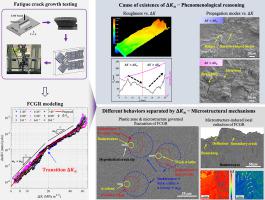当前位置:
X-MOL 学术
›
Int. J. Plasticity
›
论文详情
Our official English website, www.x-mol.net, welcomes your
feedback! (Note: you will need to create a separate account there.)
Microstructural causes and mechanisms of crack growth rate transition and fluctuation of additively manufactured titanium alloy
International Journal of Plasticity ( IF 9.4 ) Pub Date : 2024-06-11 , DOI: 10.1016/j.ijplas.2024.104034 Xinyan Wang , Mengyu Cao , Yang Zhao , Jingjing He , Xuefei Guan
International Journal of Plasticity ( IF 9.4 ) Pub Date : 2024-06-11 , DOI: 10.1016/j.ijplas.2024.104034 Xinyan Wang , Mengyu Cao , Yang Zhao , Jingjing He , Xuefei Guan

|
Wire and arc additive manufacturing (WAAM) enables rapid near-net-shape fabrications of large-size parts and in-situ remanufacturing in many industry sectors. A comprehensive understanding of the fatigue failure mechanism of WAAM titanium alloys is a prerequisite for their widespread use in critical structural components subject to fatigue load. Here, the fatigue crack growth behavior of WAAM TA15 material is investigated. Fatigue crack growth tests are performed using compact tension specimens sampled from different locations and with different crack orientations of the WAAM TA15 block. The fatigue crack growth rate (FCGR) data exhibit two governing rates separated by a transition stress intensity factor value, , and the degrees of fluctuation of the FCGR data in the two regimes are notably different. A piecewise log-linear model is first proposed by incorporating the Heaviside step function and into the classical Paris’ model, allowing for the transition to be determined by the data. The potential causes of the transition are phenomenologically inferred via fractography and surface roughness profiling results. The critical microstructure affecting the value of is identified by relating the crack tip cyclic plastic zone size at to the sizes of main microstructures. The cause of different degrees of fluctuations in the two regimes separated by is inferred by examining the microstructures within the plastic zone. The microstructural mechanisms of the local FCGR reduction and fluctuation are further identified and explained.
中文翻译:

增材制造钛合金裂纹扩展速率转变和波动的显微组织原因及机制
线材和电弧增材制造 (WAAM) 能够在许多工业领域实现大型零件的快速近净成形制造和原位再制造。全面了解WAAM钛合金的疲劳失效机理是其广泛应用于承受疲劳载荷的关键结构件的先决条件。在此,研究了 WAAM TA15 材料的疲劳裂纹扩展行为。使用从 WAAM TA15 块的不同位置和不同裂纹方向取样的紧凑拉伸样本进行疲劳裂纹扩展测试。疲劳裂纹扩展速率(FCGR)数据呈现出由过渡应力强度因子值 分开的两个控制速率,并且两种状态下 FCGR 数据的波动程度显着不同。首先通过将 Heaviside 阶跃函数合并到经典 Paris 模型中提出了分段对数线性模型,允许由数据确定过渡。通过断口分析和表面粗糙度分析结果从现象学上推断出转变的潜在原因。影响 值的关键微观结构是通过将裂纹尖端循环塑性区尺寸与主要微观结构的尺寸相关联来确定的。通过检查塑性区内的微观结构推断出两个区域中不同程度波动的原因。进一步确定和解释了局部 FCGR 减少和波动的微观结构机制。
更新日期:2024-06-11
中文翻译:

增材制造钛合金裂纹扩展速率转变和波动的显微组织原因及机制
线材和电弧增材制造 (WAAM) 能够在许多工业领域实现大型零件的快速近净成形制造和原位再制造。全面了解WAAM钛合金的疲劳失效机理是其广泛应用于承受疲劳载荷的关键结构件的先决条件。在此,研究了 WAAM TA15 材料的疲劳裂纹扩展行为。使用从 WAAM TA15 块的不同位置和不同裂纹方向取样的紧凑拉伸样本进行疲劳裂纹扩展测试。疲劳裂纹扩展速率(FCGR)数据呈现出由过渡应力强度因子值 分开的两个控制速率,并且两种状态下 FCGR 数据的波动程度显着不同。首先通过将 Heaviside 阶跃函数合并到经典 Paris 模型中提出了分段对数线性模型,允许由数据确定过渡。通过断口分析和表面粗糙度分析结果从现象学上推断出转变的潜在原因。影响 值的关键微观结构是通过将裂纹尖端循环塑性区尺寸与主要微观结构的尺寸相关联来确定的。通过检查塑性区内的微观结构推断出两个区域中不同程度波动的原因。进一步确定和解释了局部 FCGR 减少和波动的微观结构机制。

































 京公网安备 11010802027423号
京公网安备 11010802027423号